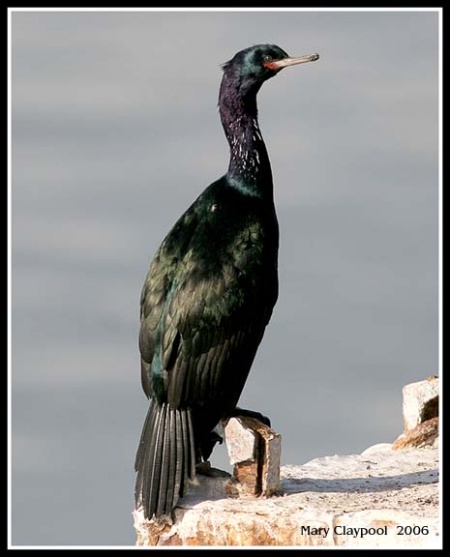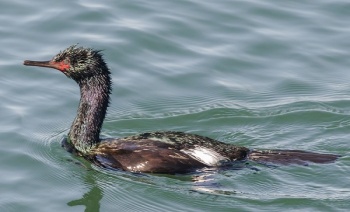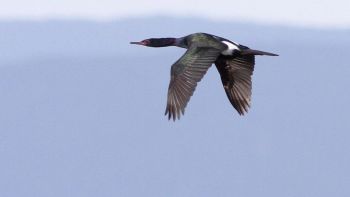- Urile pelagicus
Phalacrocorax pelagicus
Identification
Length: 51-76 cm (20.1-29.9 in)
- Black-body with a metallic gloss
- Magenta facial skin
- White patches on flanks in breeding plumage
- Throat pouch and face red.
- Crest in breeding plumage
- Tail long, neck, head and bill thin.
- Sexes similar.
Immature is all dark brown.
Similar species
Brandt's Cormorant has a heavier bill, larger head, thicker neck but shorter tail. Brandt's has blue throat pouch most evident in breeding plumage framed in yellowish brown. Immature Brandt's is dark brown with a pale brown blaze across its chest. Double-crested Cormorant has a blocky head with orange throat pouch. Immature Double-crested usually much paler often whitish on belly and an all yellow bill. In Bearing Sea may be confused with much larger Red-faced Cormorant which has a pale bill, more extensive bright red facial skin and dark blue throat pouch.
Distribution
North east Asia, the Bering sea, and Alaska to the Baja peninsula in Mexico.
Taxonomy
This is a polytypic species. Two subspecies are recognized[1]
- P. p. pelagicus - Larger. Widespread.
- P. p. resplendens - Smaller. Ranges from British Columbia to Baja California.
Habitat
Offshore and inshore waters.
Behaviour
Actions
Dives into sea for food.
Diet
Primarily fish
Breeding
It uses the same nest for several years; it is made of seaweed, grass and cemented together with its own guano. These nests can reach 5-6 feet in height. Nest typically situated on the ledge of a cliff on offshore stack or the mainland. Clutch of one to eight (usually four) greenish white to bluish eggs sometimes lightly marked with brown. Young must jump from the cliff ledge on their first flight.
Vocalisation
Low groans, croaks, or hisses, depending on situation. Greeting calls differ by sex with females often giving a ticking sound like a grandfather clock.
Movements
Most populations sedentary but perform some, mainly short-range, post-breeding dispersal. Northernmost populations migratory to SE Alaska and N British Columbia. Winter visitor to Korea, China, and Baja California. Vagrant to Hawaii.
References
- Clements, J. F., T. S. Schulenberg, M. J. Iliff, S. M. Billerman, T. A. Fredericks, B. L. Sullivan, and C. L. Wood. 2019. The eBird/Clements Checklist of Birds of the World: v2019. Downloaded from http://www.birds.cornell.edu/clementschecklist/download/
- Hobson, K. A. (2020). Pelagic Cormorant (Phalacrocorax pelagicus), version 1.0. In Birds of the World (S. M. Billerman, Editor). Cornell Lab of Ornithology, Ithaca, NY, USA. https://doi.org/10.2173/bow.pelcor.01
- Cornell Lab of Ornithology. 2019. Pelagic_Cormorant in: All About Birds. Cornell Lab of Ornithology, Ithaca, New York. https://www.allaboutbirds.org/ Accessed on 12 September 2020.
Recommended Citation
- BirdForum Opus contributors. (2024) Pelagic Cormorant. In: BirdForum, the forum for wild birds and birding. Retrieved 9 November 2024 from https://www.birdforum.net/opus/Pelagic_Cormorant
External Links
Search the Gallery using the scientific name:
Search the Gallery using the scientific name:
GSearch checked for 2020 platform.







